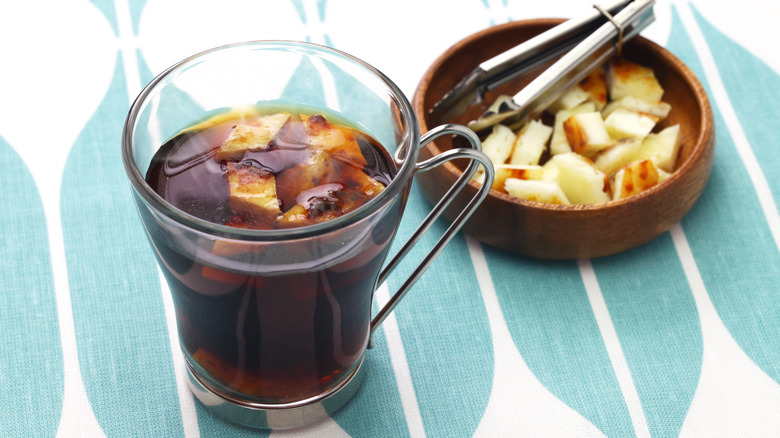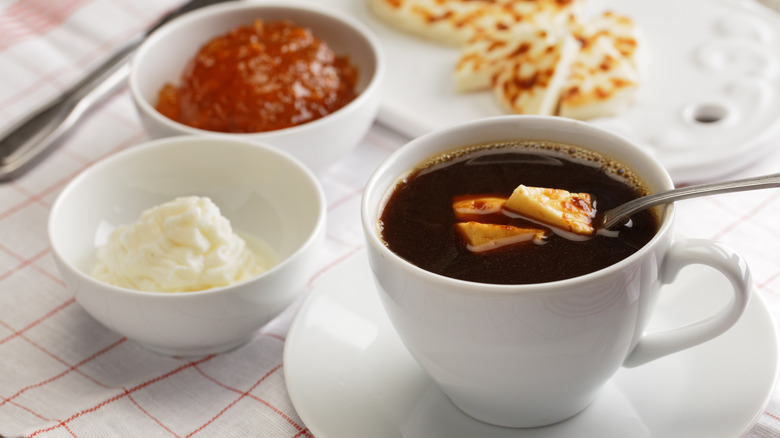The Scandinavian Tradition Of Putting 'Bread Cheese' In Coffee
Adding additional ingredients like milk, dairy-alternative milk, sugar, and flavored syrups to your morning cup of coffee is a regular occurrence by modern standards. However, in the early days of the drink's history, it was mostly enjoyed black by the Arab Muslims who first popularized the drink. This was met with skepticism from the Christian peoples of Europe who called the drink the "wine of Islam."
A part of coffee's eventual leap into European culture came in the 17th century when a Vienna coffee house owner started adding milk and honey to the drink to make it more palatable. As coffee continued to spread, the many ways to offset its bitter flavors grew as well. The Vietnamese added condensed milk and egg to their coffees, and more recently there was the diet trend of adding butter to coffee to make the "bulletproof" version of the drink. In the northernmost sections of Europe, the Saami people started adding their own preferred dairy to coffee — cheese.
Yes, that's right — a common treat for these nomadic Scandinavians is coffee with gobs of cheese, but before you go reaching for a wedge of parmesan it should be noted that it isn't any old cheese that goes into Scandinavian kaffeost.
What is Kaffeost?
The practice of putting cheese into coffee comes from the Saami people of Scandinavian countries like Finland, Norway, and Sweden. This population is mostly nomadic and dependent on their reindeer herds for sustenance in many ways. Coffee was introduced to the Saami in the mid-1700s, and they quickly took to the hardy drink, spending hours roasting the beans to a richly dark complexion.
They also spiked their coffee with juustoleipä, which translates to "bread cheese." It's also sometimes referred to as "Finnish squeaky cheese" due to the squeaky noises made when it is chewed. This cheese is traditionally made using reindeer milk and is often lightly charred before it is added to the coffee.
The reason that it is called "bread cheese" is due to its porous nature which resembles the interior crumb of a slice of bread. Tiny structural holes in the cheese allow some of the coffee to actually flow through and melt the cheese ever so slightly. This cheese was also often used by the Saami in the same way we would use a slice of bread, adding to the name's significance. The coffee flavors the cheese, and the cheese in turn flavors the coffee. If you'd like, you can take a bite out of the cheese after a few sips — you're certainly free to do so — but you can also wait until the end to snap into your squeaky, coffee-soaked cheese.
What does putting cheese in coffee taste like?
Bread cheese is great for going into coffee because of its porousness, but it also has a unique flavor that makes it well-suited to being paired with coffee. It's got a light texture, and it's also fairly sweet for cheese. That means that when you add it to your cup of joe you're basically adding milk and sugar at the same time. The process of charring the cheese before it's added to the coffee also deepens these sweet flavors by caramelizing some of its sugars.
As noted by Nordstjernan, University of Wisconsin-Madison professor Tom DuBois alleges that the flavor of adding this cheese to coffee is actually quite similar to cheesecake. Others have described it as tasting like coffee-infused cheesecake or tiramisu as well.
If this has you curious and you want to try kaffeost for yourself at home, it's best to find a squeakier cheese for it. If you can't though, then consider finding a soft, porous, and sweet cheese that will come as close as possible to the original flavor. Cheese curds, brie, and halloumi all supposedly add the right level of mild tangy cheese flavoring to a cup of coffee. While adding cheese to coffee might sound like an odd idea, kaffeost is ingrained in the Saami culture, and may just be the next big coffee trend.


